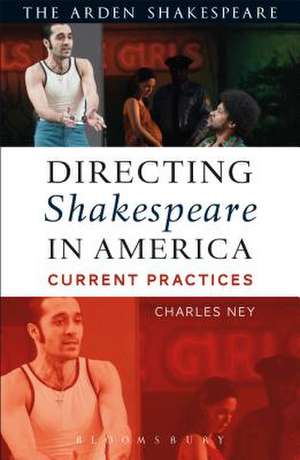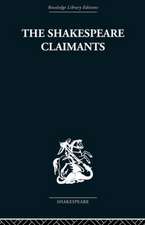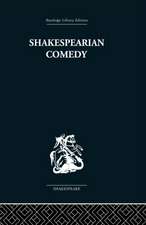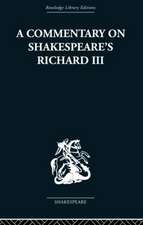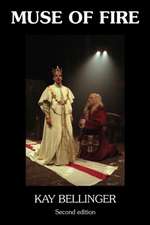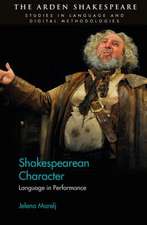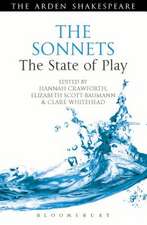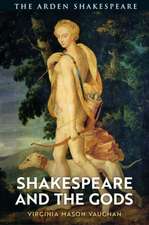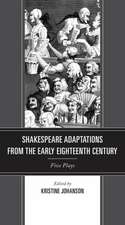Directing Shakespeare in America: Current Practices
Autor Charles Neyen Limba Engleză Paperback – 24 feb 2016
| Toate formatele și edițiile | Preț | Express |
|---|---|---|
| Paperback (2) | 179.98 lei 3-5 săpt. | +46.28 lei 6-12 zile |
| Bloomsbury Publishing – 24 feb 2016 | 179.98 lei 3-5 săpt. | +46.28 lei 6-12 zile |
| Bloomsbury Publishing – 19 feb 2020 | 179.98 lei 3-5 săpt. | |
| Hardback (2) | 598.76 lei 6-8 săpt. | |
| Bloomsbury Publishing – 14 noi 2018 | 598.76 lei 6-8 săpt. | |
| Bloomsbury Publishing – 24 feb 2016 | 714.92 lei 6-8 săpt. |
Preț: 179.98 lei
Preț vechi: 208.33 lei
-14% Nou
Puncte Express: 270
Preț estimativ în valută:
34.44€ • 36.03$ • 28.61£
34.44€ • 36.03$ • 28.61£
Carte disponibilă
Livrare economică 13-27 martie
Livrare express 26 februarie-04 martie pentru 56.27 lei
Preluare comenzi: 021 569.72.76
Specificații
ISBN-13: 9781474239837
ISBN-10: 1474239838
Pagini: 376
Ilustrații: 10 bw illus
Dimensiuni: 129 x 198 x 21 mm
Greutate: 0.41 kg
Editura: Bloomsbury Publishing
Colecția The Arden Shakespeare
Locul publicării:London, United Kingdom
ISBN-10: 1474239838
Pagini: 376
Ilustrații: 10 bw illus
Dimensiuni: 129 x 198 x 21 mm
Greutate: 0.41 kg
Editura: Bloomsbury Publishing
Colecția The Arden Shakespeare
Locul publicării:London, United Kingdom
Caracteristici
Gives
practical
advice
and
tips
about
the
craft
of
directing
Shakespeare:
structured
to
mirror
the
process
from
page
to
stage
Notă biografică
Charles
Neyis
a
professor
and
Head
of
Directing
in
the
Department
of
Theatre
and
Dance
at
Texas
State
University,
USA.
He
has
been
artistic
director
at
Manhattan
Clearing
House
Contemporary
Performing
Arts
Center,
Idaho
Repertory
Theatre
and
Mary
Moody
Northen
Theatre.
Other
directing
credits
include
New
York
City's
Working
Man's
Clothes
Theatre,
the
Kennedy
Center,
Illinois
Shakespeare
Festival
and
Texas
Shakespeare
Festival.
Cuprins
Chapter
1:
Introduction
Chapter
2:
The
Directors
and
their
Aesthetic
Sensibilities
Chapter
3:
Developing
an
Approach
Chapter
4:
Research
and
Analysis
Chapter
5:
Preparing
the
Production
Text
Chapter
6:
Working
With
Designers
Chapter
7:
Casting
Chapter
8:
Rehearsals
Chapter
9:
Table
Work
Chapter
10:
Staging
the
Play
Chapter
11:
Speaking
Shakespeare's
Language
Chapter
12:
Middle
Stage
Rehearsals
Chapter
13:
Other
Thoughts
on
Rehearsal
Chapter
14:
Tech
and
Dress
Rehearsals
Chapter
15:
Adding
the
Audience
Recenzii
[Ney's]
research
is
impressive
and
unique.
Mr. Ney sets a new standard for the study of directing Shakespeare in the USA, deftly interviewing leaders in the field and opening up the remarkable visions, unique processes and historical research that drives the production of the Bard's work in festivals and theatres nationwide. . . . No doubt, Directing Shakespeare will be a welcome text for classrooms worldwide providing students with the "best practices" of notable directors . . . It's also a great read for seasoned professionals seeking a glimpse into the personalities and process of many of America's most successful directors.
Charles Ney's Directing Shakespeare in America: Current Practices is an illuminating and much-needed resource for directors, scholars, students, and Shakespeare aficionados . Ney demonstrates a remarkable ability to curate this wealth of wisdom in a way that is compelling and easy to follow . The book is engaging as a straight read-through, but it's equally useful for the reader that wants to skip ahead and explore concise essays on various topics, such as approaches to table work, or how to navigate tech and previews. These practices are invaluable for directors of Shakespeare, but can be more broadly applied as resources for directing any kind of live theatre . Ney's book astonishingly avoids privileging one approach over another. This is a study that attempts to truly capture diverse approaches and contextualize them . This book is an effective snapshot of an incredibly diverse body of work and a must read for Shakespeare directors, scholars, and enthusiasts.
Ney and his interviewees convey the vitality of performances recreated through the eyes of those who headed them . The book records stage practices at a moment in time when some of the boldest directors are relaying their understanding of Shakespeare's theatre by scanning its longer history of production.
Ney's incisive introductions to each chapter cogently frame the emergent patterns of thought vis-à-vis each topic without eliding their inherent contradictions and complexities and could well stand on their own as a survey of contemporary practice that is both wide-ranging and rich in detail. Political, practical, and aesthetic issues all get a thorough and inclusive treatment bound to stimulate lively discussion in graduate level directing seminars . In addition to the immense practical value of its nuts and bolts approach to the entire arc of the directing process the book also provides a kind of meta-analysis of the beliefs and positions beneath the surface of contemporary Shakespearean practice and this is, perhaps, the book's most compelling feature . Its potent combination of practical wisdom and abstract reflection make it a truly stimulating read for novice and veteran directors alike.
Directing Shakespeareis as much a tribute to prominent American directors of Shakespeare as a presentation of critical approach to staging Shakespeare's plays . The book often reads like a roundtable discussion on directing, with Ney deftly leading the discussion . Throughout the book, readers will find pragmatic advice, amusing anecdotal examples, humor, and brutal honesty. Beginning directors will find Ney's approach especially helpful because they can read the book from cover to cover for guidance through the directing process. It is likely that other directors will turn to the book for valuable insight while they are in the process of directing their own Shakespearean productions . It adds valuable insight and specific geographic perspective that is often absent in Elizabethan theatre studies . Ney uses the thoughts, reflections, and opinions of this broad group of directors and companies to create a wide-ranging, thoughtful, and inspiring conversation on the directing process and the purpose of theatre.
Illuminates the process of bringing Shakespeare's plays to life on stage and makes an important contribution to both theatre history and theatre practice . Actors will find out what is required of a Shakespearean performer and what it takes to get hired in the first place. Critics and scholars will find a useful context to help them view and analyse the work. I would certainly recommend this book to anyone preparing to work with one of these directors, all of whom remain active in the profession.
Mr. Ney sets a new standard for the study of directing Shakespeare in the USA, deftly interviewing leaders in the field and opening up the remarkable visions, unique processes and historical research that drives the production of the Bard's work in festivals and theatres nationwide. . . . No doubt, Directing Shakespeare will be a welcome text for classrooms worldwide providing students with the "best practices" of notable directors . . . It's also a great read for seasoned professionals seeking a glimpse into the personalities and process of many of America's most successful directors.
Charles Ney's Directing Shakespeare in America: Current Practices is an illuminating and much-needed resource for directors, scholars, students, and Shakespeare aficionados . Ney demonstrates a remarkable ability to curate this wealth of wisdom in a way that is compelling and easy to follow . The book is engaging as a straight read-through, but it's equally useful for the reader that wants to skip ahead and explore concise essays on various topics, such as approaches to table work, or how to navigate tech and previews. These practices are invaluable for directors of Shakespeare, but can be more broadly applied as resources for directing any kind of live theatre . Ney's book astonishingly avoids privileging one approach over another. This is a study that attempts to truly capture diverse approaches and contextualize them . This book is an effective snapshot of an incredibly diverse body of work and a must read for Shakespeare directors, scholars, and enthusiasts.
Ney and his interviewees convey the vitality of performances recreated through the eyes of those who headed them . The book records stage practices at a moment in time when some of the boldest directors are relaying their understanding of Shakespeare's theatre by scanning its longer history of production.
Ney's incisive introductions to each chapter cogently frame the emergent patterns of thought vis-à-vis each topic without eliding their inherent contradictions and complexities and could well stand on their own as a survey of contemporary practice that is both wide-ranging and rich in detail. Political, practical, and aesthetic issues all get a thorough and inclusive treatment bound to stimulate lively discussion in graduate level directing seminars . In addition to the immense practical value of its nuts and bolts approach to the entire arc of the directing process the book also provides a kind of meta-analysis of the beliefs and positions beneath the surface of contemporary Shakespearean practice and this is, perhaps, the book's most compelling feature . Its potent combination of practical wisdom and abstract reflection make it a truly stimulating read for novice and veteran directors alike.
Directing Shakespeareis as much a tribute to prominent American directors of Shakespeare as a presentation of critical approach to staging Shakespeare's plays . The book often reads like a roundtable discussion on directing, with Ney deftly leading the discussion . Throughout the book, readers will find pragmatic advice, amusing anecdotal examples, humor, and brutal honesty. Beginning directors will find Ney's approach especially helpful because they can read the book from cover to cover for guidance through the directing process. It is likely that other directors will turn to the book for valuable insight while they are in the process of directing their own Shakespearean productions . It adds valuable insight and specific geographic perspective that is often absent in Elizabethan theatre studies . Ney uses the thoughts, reflections, and opinions of this broad group of directors and companies to create a wide-ranging, thoughtful, and inspiring conversation on the directing process and the purpose of theatre.
Illuminates the process of bringing Shakespeare's plays to life on stage and makes an important contribution to both theatre history and theatre practice . Actors will find out what is required of a Shakespearean performer and what it takes to get hired in the first place. Critics and scholars will find a useful context to help them view and analyse the work. I would certainly recommend this book to anyone preparing to work with one of these directors, all of whom remain active in the profession.
